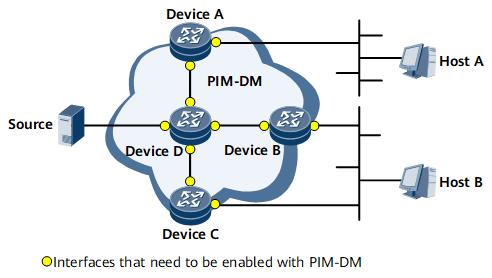PIM-DM Intra-domain
Service Overview
Continuing development of the Internet has led to considerable growth in the types of data, voice, and video information exchanged online. New services, such as Video on Demand (VOD) and Broadcast Television (BTV) have emerged and continue to develop. Multicast plays an increasingly important role in transmitting these services.
Multicast services are deployed on the small-scale network shown in Figure 1. An IGP has been deployed, and each network segment route is reachable. Group members are distributed densely. Users want to receive VoD information without consuming too many network bandwidth resources.
Networking Description
On the network shown in Figure 1, Hosts A and B are multicast information receivers, each located on a different leaf network. The hosts receive VoD information in multicast mode. PIM-DM is used throughout the PIM domain. Device D is connected to the multicast source. Device A is connected to Host A. Devices B and C are connected to Host B.
PIM-DM is enabled on all router interfaces.
IGMP runs between Device A and Host A, between Device B and Host B, and between Device C and Host B.
When configuring IGMP on router interfaces, ensure that interface parameters are consistent. All routers connected to the same network must run the same version of IGMP (IGMPv2 is recommended) and be configured with the same interface parameter values, such as the Query timer value and hold time of memberships. If the IGMP versions or interface parameters are different, IGMP group memberships are inconsistent on different routers.
Hosts A and B can receive VoD information.
